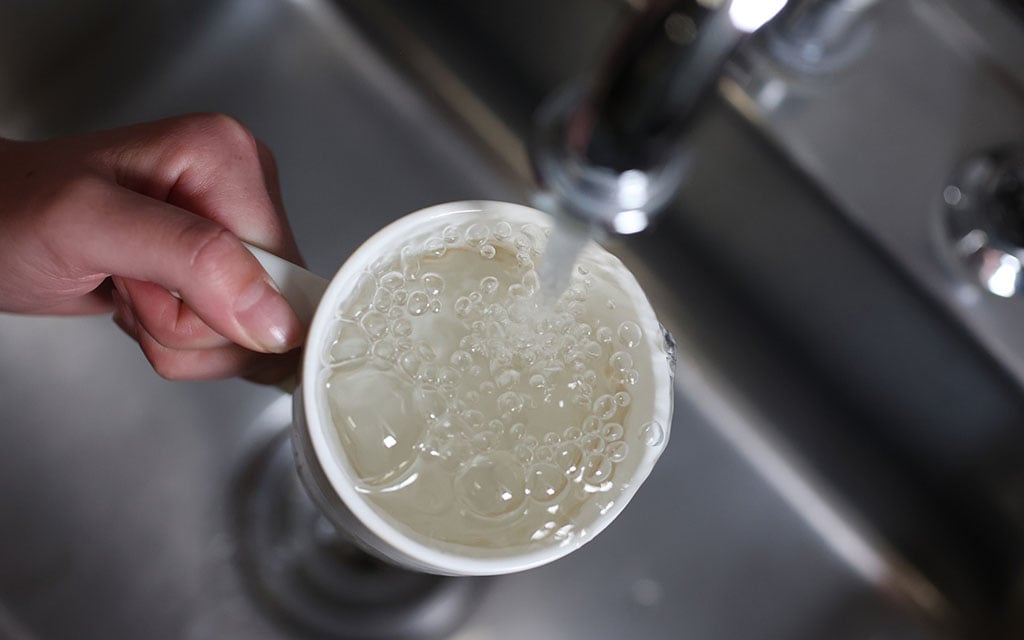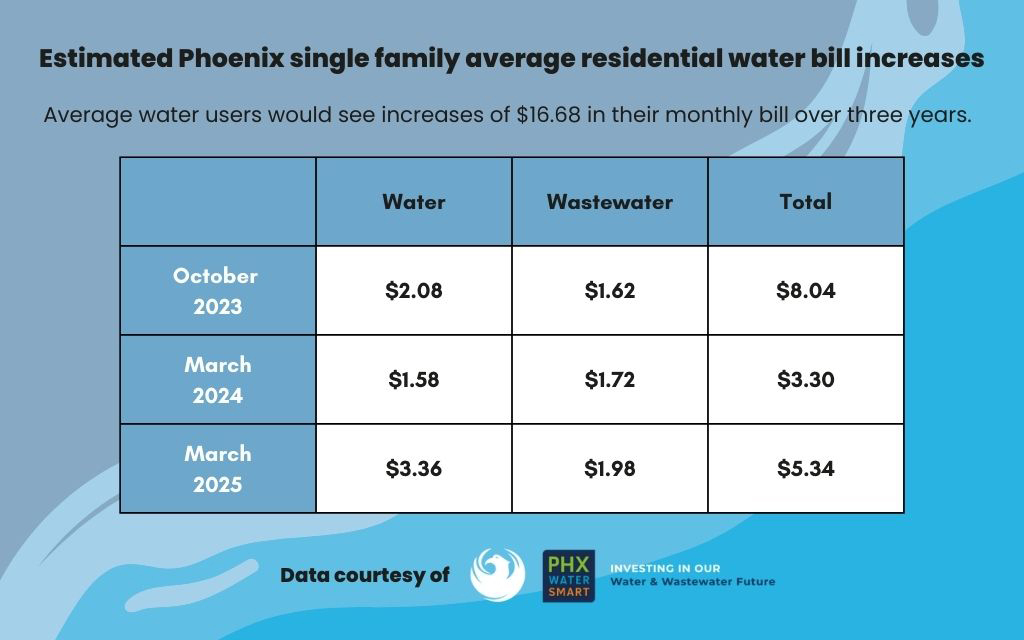
The city of Phoenix is considering increases to its water rates in response to the ongoing drought and rising costs of labor, electricity and chemicals used to treat water and wastewater. (Photo by Sam Ballesteros/Cronkite News)
PHOENIX – Phoenix residents could see an increase in their water bills soon. Although the Valley has seen more rain than normal this winter, with almost an inch more than the average in March, it wasn’t enough to combat the ongoing drought in Arizona.
The Water Services Department is proposing a phased rate increase to address the rising cost of water and water treatment and to encourage conservation. But one department official said the proposed higher rates would still be “extremely affordable” for most customers.
“There was a national affordability study that was done last year, and the city of Phoenix has been recognized as some of the most affordable water and wastewater rates in the nation,” said Troy Hayes, water services director for the city of Phoenix.
What is the current water rate for Phoenix customers?
Phoenix water customers are currently billed at a flat rate that allows up to 4,488 gallons of water during the cooler months of October to May and 7,480 gallons in the hot, dry months from June to September. The rate varies based on the size of a customer’s water meter – the larger the line, the more the cost – and where the customer lives. Those who live outside Phoenix are charged an additional 50%.
On top of these charges, customers pay user, environmental and other charges.
What are the proposed rate increases?
The proposed rate increase would raise water service costs for the average, in-city resident customer by 6.5%, or about $2 a month, in October, according to city estimates, though the increases will vary by customer. That would be followed by another 6.5% increase next March, and a 13% increase in March 2025
The city, with an eye on conservation, also wants to lower the amount of water residential customers receive under the flat rate, from 4,488 gallons to 3,740 in winter months and from 7,480 to 5,984 in hotter months. That could end up costing some residents an extra $4 a month, if their consumption exceeds the new, lower thresholds, according to city estimates.
The plan also calls for similar increases in the cost of wastewater service: It would rise by 6.5%, or about $1.60 a month, in October, another 6.5% in March and by 7% in March 2025 for an average user.

Finally, the city is considering an increase in the stormwater excise tax, required under the federal Clean Water Act to maintain storm drains and keep waterways clean. It would go from the 20 cents most residential customers currently pay as part of their water bill, to 45 cents in October because of new and expanded permit requirements.
What problems are the increased rates trying to solve?
Hayes said one reason behind these increases is the ongoing drought in Arizona.
Phoenix introduced a drought management plan in 2015, and reaffirmed it in 2021, that aims to make residents more aware of their water usage and highlight what the city is doing to prevent drought impact from increasing.
The city gets about 41% of its water from the Colorado River, 56% from the Salt and Verde rivers and the remaining 3% from groundwater. As the Colorado River continues to dwindle, this plan asks residents to think about their water usage and how they can save more water, but it does not institute cutbacks to residential service..
Hayes said the unpredictable drought conditions are driving the need for rate increases.
“The raw water costs on the water side, where we have to purchase water from the Salt River Project and from the Central Arizona Project – to be able to treat that – those costs are escalating over the past few years as well,” said Hayes. “And as we continue further into the drought, it’s really difficult to say how far the cost of raw water will go up.”
He said another reason for the proposed increases is simply because the Water Services Department is facing an increase in its costs, ranging from the cost of electricity to the price of chemicals used to treat water and wastewater, and rising labor costs.
“The city of Phoenix is proposing some labor changes, we’ve accounted for those in these rates,” said Hayes, noting the city is seeking the best available talent “to make sure we’re delivering safe, clean, reliable water to our customers.”
Hayes said these changes include raises for staff fixing water and sewer lines, operating the water and wastewater facilities and operating the call center.
How do proposed rates compare to other cities in the Valley?
Several other cities in the Valley, including Tempe and Chandler, have their own drought management plans, but neither has resorted to increasing water rates yet. A lot of this has to do with where each city gets its water, said Simone Kjolsrud, Chandler’s water resources manager.
“Chandler has a different mix of supplies from Phoenix, from Peoria, from Scottsdale, from Tempe,” said Kjolsrud. “We’re all using a different amount of Colorado River water.”
She said that affects each city’s water management plans.
“It’s just an important thing to remember that each of our drought management plans is going to be tailored to our specific city. And it’s going to be tailored to our particular water resource portfolio,” Kjolsrud said. “So a city that doesn’t use Colorado River supplies might not move into … further stages of their drought management plan.”
According to Kjolsrud, Chandler only gets about 37% of its water from the Colorado River, slightly less than Phoenix.
Right now, Chandler and Tempe have only implemented the first stage of their drought preparedness plans and are keeping a close eye on what is happening to their water supplies. Both cities have recommended that residents pay more attention to their water usage, but have not implemented any sort of requirements or rate increases.
“The updated drought preparedness plan allows Tempe to track and respond to multiple scenarios that may lead to supply shortage, including drought conditions in the watershed that supports the Colorado River,” said Tina Sleeper, Tempe’s interim water resources manager.
When will decisions about Phoenix’s proposed rate increases be made?
The city of Phoenix has been holding a series of 14 meetings at each of the city’s village planning committees that started March 15 and will continue through May 9. These meetings are open to the public, and the city is encouraging residents to come listen to details of the proposal, ask questions and provide.
There are also seven general public meetings, both virtual and in-person, and three council district meetings scheduled on the subject.
Hayes said a final city council vote is expected on June 28, 2023.



